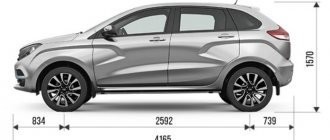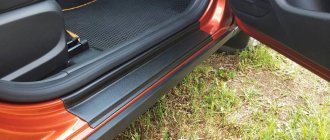The domestic one is trying to occupy the station wagon niche in the Russian market with the brand new Lada Vesta SW.
Having thoroughly studied the technical characteristics of the model, it is worth immediately noting its improved conditions for rear passengers when compared with the sedan. The designers also worked on the suspension and made a sloping roof on the trunk.
Let's analyze the Lada Vesta SV station wagon more thoroughly and find out all the features of the car, which has taken a position between the popular sedan and the brand new Cross crossover.
↑ interior and luggage compartment dimensions
The new platform used to create the sedan made it possible to make the car not only larger, but also more comfortable. The Lada Vesta's interior dimensions are also very impressive: there is much more free space for both the driver and passengers than in previous Lada models. Main interior dimensions, meters:
- the distance between the driver's seat cushion and the ceiling is 0.93-0.99;
- distance between the rear passenger seat cushion and the ceiling – 0.885;
- free space between the back of the front seat and the legs of the passenger sitting behind – 0.226;
- front seat cushion length – 0.45;
- rear seat cushion length – 0.48.
Taking into account the specifics of operating budget sedans in our country, which involves the periodic transportation of certain cargoes, the designers made sure that Vesta received a fairly spacious trunk.
Main dimensions of the cargo compartment, meters:
- height – 0.573;
- length - 0.962 (1.675, if the rear seat backs are folded);
- width max./min. – 1.424/1.033;
- loading height – 0.717.
The useful volume of the trunk is about 480 liters, and it can accommodate cargo weighing up to 400 kilograms.
Thus, AvtoVAZ specialists managed to design not only an attractive and reliable car, but also a very practical, convenient and functional one, maximally oriented towards the average Russian driver with an average income.
Salon Lada Vesta SV cross
Since the cross body car came out at the end of '17, its interior is no different from the '18 car. Both the driver and the passenger feel comfortable sitting in the Cross. Many people are interested in the question of whether the Lada Vesta has 7 seats, the answer is: it doesn’t, there are no 7 seats in the interior of the crossover, there are only 5 of them.
Let's start with the Cross steering column; outwardly it is no different from the steering wheel of a Vesta sedan - all the same buttons for controlling the multimedia system. However, there are differences: in any configuration of the Vesta Cross, the steering wheel is covered with leather.
Photo of the interior of the cross modification
The central panel is no different from the sedan, everything is still harmoniously located in its place, which makes driving easier. There is a glove box mounted on the panel on the right; it has a decent volume. In the center of the cabin there is a central tunnel with cup holders and a gear knob. The handle of the box depends on what kind of box is on the car.
After the gearbox there is an armrest, convenient for the elbow of the right hand. The plastic in the cabin is the same everywhere, in the door cards and on the dashboard. Door cards have harmonious inserts that highlight the design. The doors have spacious containers in which you can put small things or a bottle of drink. Overall the door finish looks decent. Each door has its own electric lift, and the driver's window control unit with rear door locking and mirror adjustment.
The Vesta Cross floor is carpeted everywhere. It can be called a classic flooring material in many foreign cars and vases. The ceiling on Vesta Cross is light, but it is made with high quality; in case of contamination, the dirt can be easily washed off.
Hatchback and liftback: what's the difference?
The abundance of car body types can make it difficult for a novice motorist to choose a car. In such a situation, you have to process large amounts of information in order to get to the bottom of it and, for example, understand how a liftback differs from a hatchback. Not all of these passenger cars, which are quite similar in many characteristics, will be able to quickly distinguish them in traffic.
Hatchback parameters This body type has been developed since the middle of the last century. Its name contains two English words “hatch” - hatch and “back” - rear.
In fact, this describes the presence of a door on the rear side of the car. This door is not used for boarding passengers, but for comfortable stowing luggage or cargo. Manufacturers offer both three-door and five-door hatchback models.
The main design solution is to combine the luggage area located at the rear with the passenger compartment into a single space. Thus, the result is a two-volume car, in contrast to a three-volume sedan.
A nice bonus for hatchback owners will be the presence of reduced rear overhangs, which not only makes parking better, but also makes it easier to maneuver in confined spaces.
Characteristic features include the presence of front-wheel drive and a transverse engine arrangement.
It is advisable to look at the hatchback and liftback from the side; you can see the difference between them from this angle. In a hatchback, the fifth door runs from the roof to the signal stops in a smooth line, without sharp bends. The profile of such a case is close to a teardrop shape.
Characteristics of a liftback The name of this type of car is a composite of two English words: lift - to lift and back - rear part. In some sources the name “liftback” is found. This type is included in the group of passenger cars and has a visual similarity to both sedans and hatchbacks.
The liftback is classified as a two-volume body type because its interior is combined with a luggage area. However, the space dimensions for suitcases and bags are larger here than in a similar hatchback class.
This is due to the increased overhangs at the rear, which also add internal volume.
Features and disadvantages of the luggage compartment
- To fully fold the rear row of seats into a flat platform, you will need to remove the headrests. Otherwise, they will rest against the back of the front seats. The angle of the seat layout will not exceed 160 - 165°;
- To remotely unlock the rear door lock, you need to press the mechanical key fob button twice;
- Lifting the trunk lid requires a lot of effort; the door is moderately heavy;
- A solid rubber mat on a raised shelf is impractical, since with frequent use of a spare wheel or a mechanical jack, the sides touch the fleecy covering, wearing it out.
Vesta SV station wagon dimensions - everything will fit
The Lada Vesta SV combines the compactness of a sedan and at the same time the spaciousness of the Cross Vesta. The dimensions of the car correspond to the station wagon class. The dimensions of the station wagon body are as follows: vehicle length - 4,410 meters, width along the body - 1,764 meters. Dimensions of the station wagon in height: with roof rails 1.512 meters, from the floor to the body part - 0.178 m. Other characteristics of the Vesta station wagon: wheelbase -2.635 meters, wheel track - 1510 mm.
Vesta SV is taller and more spacious than the sedan. It has 5 seats, the distance above the head of the rear seats has been increased by 0.25 meters. The sw and cross can carry long loads; if you fold the rear seats, the resulting space can accommodate 825 liters. You can use the space under the raised floor, which is another 95 liters of volume
It is not the bare space of the luggage compartment that attracts attention; it is equipped with compartments, nets and hooks in which various things are placed
Convenient for parking in hard-to-reach places, driving over obstacles, on bad roads.
Detailed technical specifications
Lada Vesta SW and Lada Vesta SW Cross
A distinctive feature from the sedan is the increased headroom for rear passengers by 25 mm .
The trunk volume of the Lada Vesta SV is 480 liters , however, if you fold the rear sofa (which, by the way, folds in the ratio of 1 to 3 and 2 to 3), we already get 825 liters , here you can add 95 liters of a niche under the false floor (and under It also has a spare tire!). What’s even more surprising is how AvtoVAZ thought through its organization: all sorts of niches, hooks, nets will allow you to transport any cargo.
Hi all! Lada Vesta Cross is gaining more and more popularity. Today Vesta has become one of the best-selling cars in Russia. And the Cross version is not far behind. I would like to hope that AvtoVAZ did something fundamentally different from its previous cars. Yes, the cross version is as unified as possible with the sedan. Therefore, the overall dimensions of the Lada Vesta SV Cross 2022 will be very close to the dimensions of the sedan.
Who is this car suitable for?
Lada Granta liftback is perfect for young people as a first vehicle. This decision was made due to the fact that the car has a stylish appearance and is unpretentious in maintenance. The cost of parts is low, and their replacement in case of breakdown is very simple. In addition, this car is practical and consumes a small amount of fuel.
Lada Granta is a good example of the beginning of fruitful cooperation between AvtoVAZ and Japanese Nissan and French Renault.
Considering all the advantages and everything that is new, the Lada Granta liftback occupies an important place in the development of the domestic automotive industry
Exterior
The design of the exterior was a success, and few can argue with that. The front acquired aggressiveness thanks to the correct layout of the head optics and radiator grille. The headlights also did not disappoint: they fit well into the overall design and look good. On the side of the sedan there are stamped “boomerangs”, which some people don’t like, but without them the car would clearly lose its originality.
The rear view is also good: the headlights are partially moved to the trunk lid and are in contact with the side stamped, which looks very stylish. Much dissatisfaction among many was caused by the overly large gas tank hatch, which we can completely agree with: it could have been reduced or stylized into an oval shape.
I would also like to say about the lemon color, which has become Vesta’s signature. You will have to pay an additional 30 thousand for this coloring, but it is worth it. Also, the car suits cherry, black and even yellow, so car owners have a choice: overpay for an exclusive or be content with the standard, which is also, in general, not bad.
↑ Body characteristics and dimensions
In the manufacture of the body of the new Lada, exclusively high-strength steel alloys are used; it was decided to do without aluminum and other expensive materials, which are popular in the modern automotive industry. This approach made it possible to offer one of the most competitive prices in class B+ in comparison with foreign models, as well as to make the body as rigid and safe as possible, with a minimum of vibrations and extraneous noise.
When producing Vesta, AvtoVAZ uses new design technologies and the selective inclusion of high-strength special alloys in the body structure. Thanks to this, it is possible to avoid deviations in the geometry and dimensions of the body, prevent door skewing, and ensure good handling.
Initially, it was planned that the new model would replace the Priora in the VAZ line, although in all respects the new model is superior to the Tolyatti bestseller.
Main dimensions of Lada Vesta, meters:
- height – 1.497;
- body length – 4.41;
- wheelbase - 2.635;
- body width – 1.764;
- front track width – 1.5;
- rear track width - 1.51;
- turning radius – 5.2;
- aerodynamic drag coefficient – 0.82;
- ground clearance - 0.171.
AvtoVAZ specialists, when designing the overall dimensions of the Lada Vesta, were guided by its subsequent operation in domestic conditions, so the car is ideal for traveling on Russian roads. For example, thanks to the increased wheelbase, the car has excellent directional stability and controllability even on uneven road surfaces. A sufficiently high ground clearance makes it possible to overcome difficult sections of the road that many competitors cannot overcome.
What do we end up with?
The dimensions of the Lada Vesta Cross, compared to similar cars in this class, turned out to be slightly larger. This gives Vesta Cross more spaciousness in the interior and attractive exterior.
Thanks to such combinations of size, attractiveness and cross-country ability, Vesta Cross is becoming increasingly popular among car owners. And color solutions, for example the color of the Lada Vesta SV Pluto, will not leave anyone indifferent.
in Vesta SV 01/10/2018 2,
The domestic one is trying to occupy the station wagon niche in the Russian market with the brand new Lada Vesta SW.
Having thoroughly studied the technical characteristics of the model, it is worth immediately noting its improved conditions for rear passengers when compared with the sedan. The designers also worked on the suspension and made a sloping roof on the trunk.
Let's analyze the Lada Vesta SV station wagon more thoroughly and find out all the features of the car, which has taken a position between the popular sedan and the brand new Cross crossover.
dimensions and dimensions in centimeters, length, width
LADA Largus has long won the sympathy of Russian car enthusiasts
Drivers often pay attention to the large trunk volume of the Lada Largus, which is considered the main advantage of this car. Domestic cars also cope well with another task - providing inexpensive and comfortable travel on modern roads
These two aspects and the ability to accommodate a large number of passengers allowed the car, produced at the Russian AvtoVAZ, to become a popular model in the CIS countries.
The dimensions of the Largus trunk depend on the body variation, it can be:
Each car variation has its own luggage compartment volume. In a station wagon designed for 5 seats, the volume of this compartment is 700 liters. But the owner of this model can transport a large load. In the Lada Largus station wagon, the trunk volume can be increased to 1500–1800 liters by removing the second row of seats - a three-seater sofa. With the seats folded down, the station wagon's luggage compartment volume increases to 2,350 liters.
The Largus van has the largest trunk dimensions. In this variation of the car there is no back row of seats, and sometimes even two, and the body is elongated. Officially, the van's trunk capacity is 2,500 liters. The main task of the model is to transport goods, so there are no additional components or elements inside the body.
The van has a reinforced suspension, as this model is designed for transporting large cargo. Station wagons do not have this option.
Cross
The smallest trunk size is in the Largus minivan, designed for 7 seats. The Largus Cross trunk reaches a volume of 200 liters. The manufacturer helped car owners by allowing them to increase the volume of the luggage compartment in liters to 1600–1800, for which two rows of seats should be removed.
The seven-seater version (minivan) has the most “modest” luggage compartment. But the manufacturer met his loyal customer halfway and endowed this modification with a simple secret: it is also possible to increase the luggage space to the same 1600–1800 liters by performing an identical operation to dismantle the stern seats. To do this, you will need to remove two planting rows.
Of course, neither a station wagon nor a minivan are designed to transport large loads, but if necessary, they will cope with this task perfectly.
Luggage compartment dimensions
Based on the above, we can conclude that the dimensions of the luggage compartment of any version of the Lada Largus are quite impressive. The general dimensions of this compartment for the models are as follows:
- opening height is 920 mm;
- the opening width is 980 mm;
- the height of the luggage compartment to the ceiling is from 870 to 930 mm for universal models and up to 1000 mm for a van;
- trunk length is 480–1570 mm for station wagons up to the 3rd and 2nd row of seats;
- The length of the van's luggage compartment is 1800 mm to the dividing wall;
- luggage compartment width – 1000–1450 mm.
Advantages and disadvantages
To make the right decision, you need to study not only the advantages, but also the disadvantages of the model. The owners, who have extensive experience in operating Largus, found one drawback. The car manufacturer did not adjust the interior of the station wagons in such a way that their owners would have the opportunity to transport large loads. If the driver nevertheless decided to load a large object into his car, then the cargo often caused damage to the interior.
Otherwise, Lada Largus owners are satisfied with everything in their cars. Among the advantages of a Russian car are the following:
- ease of loading;
- optimal dimensions;
- the ability to increase trunk capacity by removing the seats;
- high load capacity;
- possibility of modernization.
Drivers universally note the practicality and convenience of the LADA Largus trunk. Its size is quite enough to demonstrate the functionality of a domestic car, which allowed it to become a leader among its closest competitors. The manufacturer managed to competently and rationally approach the arrangement of the body space, which allows Largus to successfully transport large objects and indicates the enviable carrying capacity of the model.
Lada Largus is recommended for those drivers who want to get a car with the best consumer properties and technical characteristics.
"hatchback" viburnum
This full-fledged hatchback with 5 doors acts as a new version in the line of Kalinovsky modifications. The Kalina hatchback first appeared only in 2007, while Kalina has been produced since 1996. It is clear that drastic changes were made regarding the body, but the model also received other engines, more modern and meeting European toxicity standards.
The hatchback is ideal for passing city “traffic light” roads, as it is compact and equipped with an accurate power unit with ESVT. This ensures not only high speed characteristics, but also affects minimal fuel consumption.
The short body length (only 408 cm) helps the hatchback not only successfully maneuver among traffic, but also affects overall safety.
“Korotysh” can be called the most purchased “Kalinovskaya” model today, and this is not only a matter of novelty. Russian motorists have always liked hatchbacks, and this one is also equipped with the latest peak of auto fashion: a single key for locks, remote control. control, PU alarm and much more.
Shorty hatchback
Internal dimensions
Inside, the interior is quite spacious, and does not differ much in all three body types. There is enough space for the driver's and front passenger's legs, even if the legs are almost straightened and not bent at the knees. There is a little less space in the back seat, but at the same time, your knees do not rest against the back of the front seats.
The width of the seats is impressive and can accommodate large passengers. The same applies to the driver's seat. The steering wheel is located quite conveniently and has a large distance to the seat. Based on the width of the rear seat, the car can easily accommodate three people of average build.
Also, it is worth noting the difference in the size of the luggage compartment. In the sedan and sport body, the trunk has the same volume - 520 liters, but in the liftback, the trunk is increased to 760 liters, thanks to the modified body.
Dimensions of the Lada Vesta interior and comparison with competitors
As a basis for comparison, let's take the interior of the closest 4 competitors of our Vesta. The distance from the front seat (when the driver is sitting in it) to the ceiling is 1020 mm. If we take the competitors, then only Logan wins, it has 1030 mm, Solaris has 1015, Ravon Gentra 1015, Polo has a modest 1010 mm. The distance from the pedals to the knee and to the back of the front seat, depending on the height of the person, is in the range: 975-1175; Logan has a distance from 960 mm to 1190; Hyundai Solaris has from 970 to 1190; Ravon has numbers from 965-1145; Polo 955-1150. Interior height in the middle of the car: Lada Vesta – 1190 mm; Logan - 1210 mm; Solaris – 1200 mm; Ravon – 1170 mm; Polo – 1180 mm. The distance from the rear sofa (with a passenger) to the ceiling is 2180-925 mm; by the way, the Solaris is the same. Ravon has 960 mm, just like Logan; Polo-935 mm Distance from the back of the rear row to the front seat: Vesta from 610 to 850 mm; Logan from 645 to 855 mm; Solaris from 565 to 810 mm; Ravon from 660 to 890 mm; Polo from 632-880 mm. It is clear from the numbers that our car is not the tightest.
Color spectrum
When buying a car, among the many wishes for the car's configuration, the question arises: what color should I choose? And it’s not easy to answer. The Vesta Lada color scheme is represented by ten different shades, each of which is good in its own way. Of the entire range of colors, only one is represented by the usual two-layer enamel - glacial, the rest are so-called metallic. Each paint has its own individual code, indicating a specific place in the color palette. Representatives of AvtoVAZ have repeatedly stated about a possible increase in the variety of colors and shades. At the moment, Lada Vesta is available for sale in ten colors.
Lada Vesta body colors:
- phantom (496);
- glacial (221);
- black pearl (676);
- pluto (608);
- lime (366);
- krypton (372);
- Angkor (246);
- carnelian (195);
- platinum (691);
- blues (492).
All colors of Lada Vesta are presented on the official website of the model. The color names correspond to the specific color of the car. When choosing each of them, you can choose the option you like best. Photos of the Lada Vesta body color clearly demonstrate how the sedan will look in different colors. When choosing a specific color coating, you should consider its cost. Paint code 221 is offered free of charge. Lime looks the most unique and unlike other colors, so choosing it will cost the buyer 35 thousand rubles. This considerable amount is justified - such a car is impossible not to notice in a stream of other vehicles. For other metallized coatings you will have to pay another 12 thousand rubles to the total price of the car. When choosing paint on the AvtoVAZ website, photos in different colors change, which makes it easier to find a suitable option.
Phantom
The name of the coating speaks for itself - a smoky blue with a metallic sheen captivates with its twilight beauty. This category of paint goes well with the business-like appearance of the car. can be chosen by both a respectable person and a representative of the youth.
Glacial or classic white
This color is offered free of charge for any vehicle configuration. It is a snow-white enamel applied in two layers and does not have a metallic sheen. looks moderately bright and stylish. As a contrasting addition to this body shade, black alloy wheels and a roof are suitable, which will make the car look more sporty.
Black Pearl
One of the most popular car shades of all time is classic black. This color gives solidity to any car. has paint code 676. The pearl shine of the coating lives up to its name and makes others turn around at a passing car.
Cornelian
Carnelian color is the name of a natural stone that has a rich red or pink color. This is exactly what the representative of AvtoVAZ turned out to be. The rich shade of the body looks very expensive and beautiful. will not go unnoticed on the streets of a big city.
Platinum
Platinum color is one of the most popular among modern cars. It looks great in any lighting and, compared to other colors, it is less noticeable than dirt and dust. goes well with any wheels and accessories. This machine is designed for buyers of any age and gender.
Blues
The blues color, like the musical style, has a unique charm. The soft dark blue shade looks very beautiful and elegant. designed for people who are confident and know their worth.
The body color shades in which the Lada Vesta goes on sale are constantly updated. Their number in the future may reach twenty or more. Most body colors have a metallic effect, and this is an innovation and discovery for the Russian automobile industry. But besides this, Lada Vesta has many surprises in its painting and can surprise even completely skeptical people.
Currently, a new painting technology is used for Lada Vesta, using cataphoresis, which significantly strengthens the coating and therefore Lada Vesta is guaranteed to be protected from corrosion for six years from the date of purchase. This is an absolute innovation for AvtoVAZ, which deserves the status of a minor sensation.
Lada Vesta has only two body colors that do not fall under the “metallic” category. Three colors are the same as previous models, while the rest are new. Such a categorical change in the color scheme in the new model indicates a change in AvtoVAZ’s policy with the arrival of a new manager.
Chassis
This model, compared to other domestically produced models, has some special features. Its front track is somewhat larger than the rear one. This practice is rarely used on cars, and this feature is almost impossible to find anywhere else. The difference is certainly not significant, but it is still there. For example, the front track width of the Lada Vesta is 1410 mm, and the rear track is 1380 mm. That is, the difference in them is literally 3 cm.
The wheelbase dimensions of the Lada Vesta are somewhat inferior to their foreign counterparts, reaching only 2492 mm. Of course, this has a better effect on the maneuverability and cross-country ability of the car, but it also has its drawbacks, due to the deterioration of weight distribution on the body.
Also, the vehicle's ground clearance also applies to the chassis. It is measured in three positions - fully unloaded, with passengers, and with passengers and additional, maximum permissible cargo.
In the first position, the ground clearance will be as high as possible, since it will only take on the weight of the car, which is 1178 kg. And so, in this position, the ground clearance of the Lada Vesta model measures 170 mm.
The ground clearance of any car is calculated from the road surface to the very first point of contact with it - the engine protection. The clearance of the Lada Vesta, when 4 people are inside the cabin, is reduced to approximately 165 - 160 mm.
If you measure the ground clearance in the presence of passengers and additional cargo in the luggage compartment, it will decrease by about 5 cm. But in general, for moving around the city, the Lada Vesta has a fairly decent ground clearance.
If you measure the ground clearance, taking into account not only the weight of the body and passengers with cargo, but also the additional trailer, then it will be approximately 145 mm.
Lada Vesta SV Cross 2022 dimensions
At first glance, it seems that Vesta SW CROSS has become somewhat larger than the sedan. But alas, this is not the case. Vesta and its station wagon version have almost identical dimensions. Even the crash test results of the Lada Vesta SV cross and the sedan are almost the same.
Dimensions of Lada Vesta Cross SV:
Length - 4424 mm (sedan - 4410 mm) Width - 1764 mm (sedan - 1764 mm) Height - 1532 mm (sedan - 1497 mm) Wheelbase - 2635 mm Track - 1524/1524 mm. Ground clearance - 203 mm (sedan - 178 mm) (With the Lada Vesta SV mudguards installed, the ground clearance may become slightly lower.)
↑ Interior and luggage compartment dimensions
The new platform used to create the sedan made it possible to make the car not only larger, but also more comfortable. The Lada Vesta's interior dimensions are also very impressive: there is much more free space for both the driver and passengers than in previous Lada models.
Main interior dimensions, meters:
- the distance between the driver's seat cushion and the ceiling is 0.93-0.99;
- distance between the rear passenger seat cushion and the ceiling – 0.885;
- free space between the back of the front seat and the legs of the passenger sitting behind – 0.226;
- front seat cushion length – 0.45;
- rear seat cushion length – 0.48.
Taking into account the specifics of operating budget sedans in our country, which involves the periodic transportation of certain cargoes, the designers made sure that Vesta received a fairly spacious trunk.
Main dimensions of the cargo compartment, meters:
- height – 0.573;
- length - 0.962 (1.675, if the rear seat backs are folded);
- width max./min. – 1.424/1.033;
- loading height – 0.717.
The useful volume of the trunk is about 480 liters, and it can accommodate cargo weighing up to 400 kilograms.
Thus, AvtoVAZ specialists managed to design not only an attractive and reliable car, but also a very practical, convenient and functional one, maximally oriented towards the average Russian driver with an average income.
Lada Vesta in the line of the domestic giant AvtoVAZ is a progressive and promising car. It is designed to replace the previously popular flagship Priora model on the assembly line. The manufacturer initially included considerable overall body dimensions in its new creation, which in its class can be regarded as an attempt to gain leadership.
Let us remind you that Lada Vesta is a product of joint activity between AvtoVAZ engineers and the world-famous Renault-Nissan concern. For this car, the developers did not spare technology and created a completely new platform, which will serve in the future to create various modifications of the model. Thanks to such a base, the Russian car began to look very attractive. It acquired genuine monumentality and balance, which could not be seen in previous models. This aspect was directly affected by the dimensions. Thanks to their increase, passengers became much more comfortable inside the cabin, again in comparison with previously created models, where the dimensions were more modest.
Note that in terms of its overall dimensions, the Lada Vesta is slightly larger than its direct competitors, who are seeking glory and a pedestal in the “B” market segment.
Engine and gearbox specifications
We list all the power units available to Lada Vesta SW buyers:
- 122 l. s – 1.8 l with 5MT.
- 106 hp - 1.6 l with 5MT.
- 122 l. s – 1.8 l with 5AMT.
- 106 l. s – 1.6 l with 5AMT.
The recommended fuel type is gasoline no lower than 92. Although 95 should be considered optimal, because it is with it that most motorists manage to achieve factory performance characteristics for acceleration and acceleration of the car.
The wheel diameter on the basic version is 15 inches. If desired, you can purchase additional 16-inch wheels, which are available when upgrading to the “Image” package. The Cross crossover allows you to increase the diameter to 17 inches.
Considering the concept of the Lada Vesta SW model, there is no point in striving for larger wheels. There is no appropriate engine power and optimal transmission for them. Later in the article it will become clear where such thoughts come from.
The maximum speed corresponds to the selected motor type:
- 122 l. s – 180 km/h;
- 106 l. s – 174 km/h.
Acceleration has never been AvtoVAZ's strong point. Under ideal conditions, the station wagon can accelerate in 10.9 seconds. Engine 1.6 l with 106 hp. With. and 5ATM shows the worst results among competitors in its class. Rarely does anyone manage to come close to the stated performance of 14.4 seconds.
Equipment and options
Equipment – Standard
Price: 446,900 rubles Engine and gearbox: 1.6 87 hp, MT
The basic standard version is modestly equipped with 14-inch wheels, a 12-volt socket, airbags, child seat mounts and a cabin air filter.
Equipment – Classic
Price: 480,500 rubles Engine and gearbox: 1.6 87 hp, MT Version Lada Granta Station Wagon Classic, in addition to the standard, is equipped with an on-board computer, electric power steering, electric windows for front doors, gear shift prompt, hubcaps, etc. (see details)
Version - Classic Optima
Price: from 506,500 rubles Engine and gearbox: 1.6 87 hp and 1.6 106 hp, MT and AMT Lada Granta Universal 2022 in the Classic Optima configuration, quite well equipped, has: air conditioning, heated exterior mirrors, rear seat folds out into ratio 60/40.
Equipment – Comfort
Price: from 526,500 rubles Engine and gearbox: 1.6 87 hp and 1.6 106 hp, 1.6 98 hp AT, MT and AMT Granta Universal in the comfort modification is equipped, in addition to other modifications, with an audio system with Bluetooth, USB, Hands free , FM and SD card, side door moldings, side mirrors with turn signal indicator and door handles in body color.
Lada Granta Station Wagon Luxe
Price: from 563,800 rubles Engine and gearbox: 1.6 87 hp and 1.6 106 hp, 1.6 98 hp AT, MT and AMT Luxury equipment is equipped with fog lights, climate control, driver's seat adjustment, heated windshield, light tinting of windows, etc. (full list when choosing engines (buttons below))
Lada Granta Station Wagon Luxe Prestige
Price: from 597,800 rubles Engine and gearbox: 1.6 87 hp and 1.6 106 hp, 1.6 98 hp AT, MT and AMT Top-end Luxury Prestige equipment is equipped with heated front seats, parking sensors (parking sensors), rain sensor and lights, etc. (full list when choosing motors (buttons below))
Car body
Thanks to the already mentioned roof, the overall design of the station wagon has become faster. Because of this, the capacity has decreased slightly, but only for things. Despite the positioning of the car as a station wagon, the trunk volume turned out to be equal to that of a sedan - 480 liters. By folding the second row, you can significantly expand the usable area - a 60/40 ratio is used.
The result is a volume of 825 liters. This is where the station wagon reveals hidden potential for transporting oversized, but not small, things.
However, returning to the exterior, let's immediately move on to the length. Lada Vesta SW is 4410 mm in length. This indicates there is enough space for all passengers.
vesta sw dimensions
The only drawback is the same trunk. But given that the AvtoVAZ line has more spacious cars, buyers have plenty to choose from. If you want to use the vehicle as a truck, you should look at another station wagon model.
Overall body dimensions of Lada Vesta sedan
When a buyer decides on a car, he has to think about the amount of horsepower in the engine and the acceleration speed. But, in addition to this, he must clearly understand what overall dimensions and body characteristics he needs. This article will discuss the properties of the Lada Vesta body, its dimensions, weight and other details.
The appearance of a car depends, first of all, on the design. For the Lada Vesta it was designed by a well-known specialist in this field, Steve Mattin. This is the first Russian car that competed with imported models with its appearance and style. In addition, the Lada Vesta surpassed foreign competitors in its size.
Body characteristics and vehicle dimensions
Lada Vesta, according to European standards, belongs to class B+ cars. It contains some units and spare parts from Renault. The Lada Vesta is often compared to the Priora, but this is not entirely correct, since the dimensions of the Vesta are much larger, but the weight remains the same.
The sedan car is 4410 millimeters in length. Moreover, its width is 1764 millimeters, and its height is 1497.
Lada Vesta has an impressive distance between the wheel axles - 2635 mm. This significantly affects the comfort of the car while driving. Passengers do not feel bumps and travel with maximum comfort. The good ground clearance of the Lada Vesta allows this car to overcome difficult sections of the highway with a high degree of cross-country ability, even when heavily loaded.
The large capacity of the luggage compartment allows you to transport all the necessary things in your personal car. The interior of the Lada Vesta is very spacious, especially compared to previous models. In this sense, AVTOVAZ also made a mini-revolution. In addition to good spaciousness, the interior is quite comfortable and can be transformed.
Body Specifications
| Engine location method | Anterior transverse |
| Wheelbase | 4 by 2 |
| Drive wheels | Front |
| Body | Sedan |
| Body length | 441.0 cm |
| Width | 176.4 cm |
| Height | 149.7 cm |
| Base | 263.5 cm |
| Front wheel track size | 151.0 cm |
| Rear wheel track | 151.0 cm |
| Ground clearance | 17.8 cm |
| Trunk volume | 480 liters |
| Vehicle weight (curb) | From 1150 to 1195 kg |
| Vehicle weight (maximum permissible) | Up to 670 kg 1 |
More about the body
The weight of the Lada Vesta, despite the increase in body dimensions, remained the same as that of the Priora.
The body itself is made of steel, without the addition of aluminum or other materials, since the manufacturer did not set a goal to reduce the weight of the car. Efforts have been made to create maximum safety for the Lada Vesta, eliminating unwanted vibrations and noise.
The body turned out to be more rigid and safer, thanks to new design technologies and the targeted use of high-strength alloys. Such innovations guarantee protection against jamming and distortion of doors and improved handling. The lighter weight was justifiably sacrificed to the multiple increase in the safety level of the Lada Vesta.
More about the trunk
The trunk in the Lada Vesta turned out to be quite roomy and comfortable for a sedan. Its height in centimeters is 57.3. Width – from 103.9 to 142.4. Length – from 96.2 to 16.75. Very impressive size for such a model. In this trunk you can transport many different items that have an impressive weight, bypassing the financial costs of delivery and transportation.
More about the design and interior
Lada Vesta has a good interior, which is decorated with soft plastic. Despite this property, the plastic is quite durable. The interior of the car is upholstered in fabric and black leather. Added silver inserts. The panel is decorated with two backlight colors. It contains the necessary sensors: speedometer, tachometer, fuel level and engine temperature. The interior of the “luxury” version of the Lada is made at the level of higher-class European cars, which is a pleasant surprise.
Lada Vesta takes the Russian auto industry to a new level. This could not but affect the features of the car body, which allows Lada to compete for leadership in the market with foreign competitors. The car has respectable dimensions and relatively light weight. This is complemented by good aerodynamics and a high level of passenger safety.
Photo of the interior of the sedan modification
Inside the Lada Vesta car, materials and innovations were used that had not been used on a vase before. This made overall operation more pleasant for people; for the first time on a vase, the steering column could be adjusted for reach and installation angle. The steering wheel can be adjusted for reach by 50 mm and angle by 7 degrees. Vesta now has a multifunction steering wheel, which was not previously available on any VAZ model. The steering wheel has a three-spoke badge in the middle, it looks made with high quality and accuracy! The steering wheel has control buttons for the cruise control radio and telephone.
The instrument panel is interestingly implemented; it is grouped into three wells, all of which resembles a sports car. The quality of the panel material is good. The panel has few lamps, but despite this it looks informative. The torpedo is made of dark plastic. The center console is level with the panel, but protrudes forward a little and this is convenient for use; you don’t need to reach out to press a certain button. The console is divided into two parts, but depending on the configuration, it is located on top (in the expensive configuration there is a multimedia system with a 7-inch screen), and a branded radio in the cheaper basic version. On the second part of the panel there is a climate system separated by a row of buttons. The central tunnel is equipped with two cup holders.
The car has good visibility; the arches do not interfere with the view, as on the previous model 2170. Two airbags are built into the front panel (driver plus passenger). Regarding the interior trim, it looks high quality. The door cards, by the way, use new Soft Look plastic, are visually similar to leather. The plastic is embossed and hard to the touch. Despite the cheap materials, the interior looks quite strict and not childish, and if the car is in the Luxury configuration, the interior is equipped with additional chrome inserts. In general, Vesta’s interior looks a class higher than it is: ergonomic seats with good upholstery, all instruments and elements are arranged thoughtfully. When you get into the car, it’s pleasant to be in, you can see the road, and it’s easy to read the information on the speedometer. The seats have a high depth of adjustment, which allows tall people to feel comfortable behind the wheel. In previous models, there was limited space in the back, which was a big minus. There is ample knee room behind the driver; the distance from the rear sofa to the front seats is 226 mm. In general, it feels like the dimensions inside the car have been thought out. The seats are comfortable, the headrest follows the lines of the body and is friendly with the back of the head when standing in a traffic jam. The distance from the floor to the rear sofa is 345 mm, and from the floor to the top of the front seats is in the range from 276 to 310 mm. The distance from the floor to the steering wheel (since it is adjustable) is from 450 - 528 mm.
The main differences between a liftback and a hatchback
Both classes described above are modifications of passenger cars, similar in characteristics and driving performance to sedans from the same model range.
The differences between a liftback and a hatchback are as follows:
- The shape of the rear overhang, which makes the liftback look like a sedan;
- Door opening mechanism – on liftbacks, 2 alternative access methods can be provided;
- The liftback can be either two- or three-volume (which makes it even more similar to a sedan), while hatchbacks come only with two-volume.
It is worth noting that some manufacturers are not limited to this list, and regard the transition from a hatchback to a liftback as an opportunity for a comprehensive modernization of the series.
As an example, let's look at the Lada Granta liftback - along with a new body shape, the car received an upgraded brake system and chassis. These changes are not strictly tied to the body, and over time the domestic giant promises to transfer the innovations to the rest of the series.
For domestic consumers, both hatchbacks and liftbacks are of interest as cars for urban conditions, which are much more convenient than a sedan due to their dimensions and design solutions.
Sales of the Lada Granta liftback version have started in the country. At the same time, the new product received not only a fifth door, but also an updated design, an improved braking system, different suspension settings, and became more comfortable than a sedan. But, as Kolesa found out. Ru, most of the innovations will sooner or later migrate to it, so by and large we are talking about a comprehensive modernization of the model. But not so deep as to call it fundamental. However, judge for yourself...











